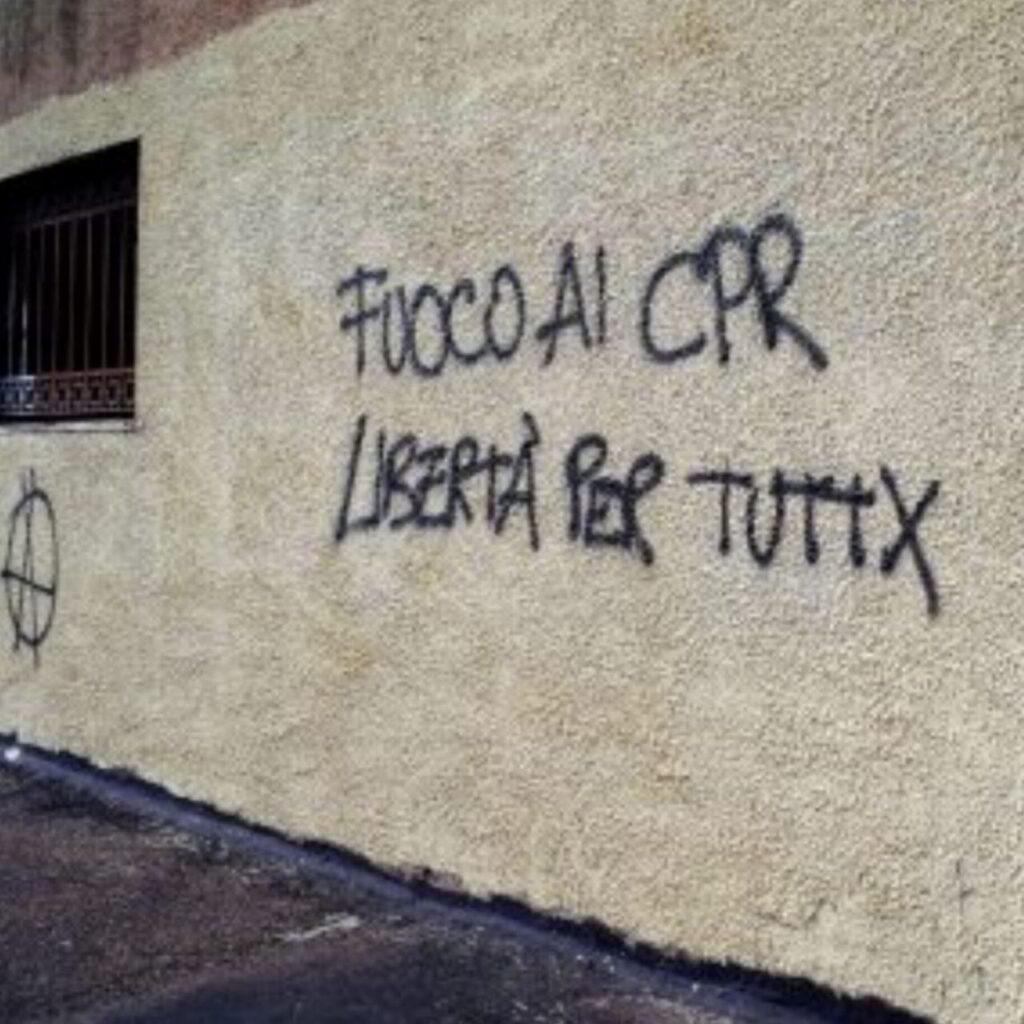
Diffondiamo
“Ho avuto un’impressione positiva di ente gestore e forze dell’ordine”, dichiarava qualche giorno fa una parlamentare – esponente di quel partito del cosiddetto centrosinistra, il PD, storicamente il principale responsabile politico dell’esistenza dei campi per le deportazioni – dopo una visita ispettiva fatta a quello di Gradisca.
L’ennesima farsa, l’ennesima narrazione ad uso e consumo dell’esistenza dei campi-lager, con qualche problema di troppo – tocca ammetterlo anche da parte agli strenui difensori della detenzione amministrativa – sulla “agibilità”. Nel rovesciamento più totale della realtà quotidiana di chi vive sulla propria pelle la detenzione a Gradisca e negli altri CPR e carceri della penisola, si mostrano le manovre più subdole per renderlo più operativo e efficace (nell’annichilimento, nel controllo dei corpi).
– “Sta nel distruggere la gabbia”
Rivolte e proteste smontano pezzo dopo pezzo l’infrastruttura della reclusione: sistemi di videosorveglianza, reti, suppellettili, lastre di plexiglass. Colpo su colpo, nei CPR, non è solo uno slogan, ma il ritmo della smontaggio delle sue gabbie. Le condizioni di reclusione e devastazione delle menti e dei corpi (“mi han portato qui per i documenti. Sono rotto giuro“, ci dice un recluso) si riflettono sull’infrastruttura (“non funziona nulla, veramente” gli faceva eco un altro): per ragioni stesse di sopravvivenza il centro deve essere smantellato.
E infatti vediamo confermata un’ipotesi che immaginavamo da tempo: l’area rossa, coinvolta nelle potenti rivolte di gennaio, è tutt’ora per la maggior parte inagibile, con due sole celle in funzione.
Il ministero dell’interno, probabilmente rincuorato dalle parole della parlamentare di opposizione – in fondo, se il servizio funziona, basta dare una spolverata agli ambienti – si affretta a dichiarare che sarebbero imminenti i lavori di ristrutturazione del centro: nuove telecamere di videosorveglianza, la creazione di varchi sicuri per l’accesso dei veicoli (in funzione deportativa?), la sostituzione delle attuali recinzioni di contenimento con barriere anti-scavalcamento (troppe evasioni?) e probabilmente la ristrutturazione dell’area rossa. In poche parole: aumentare l’efficienza del meccanismo di imprigionamento e deportazione.
In controluce, sostenute dalle vive parole di chi è recluso nell’inferno di Gradisca, si intuisce tutta la forza delle rivolte e delle evasioni.
Lo ripetiamo spesso, si tratta delle uniche forme di resistenza possibile dall’interno alla macchina della detenzione e della deportazione, dispositivi tuttavia contrastabili e infrangibili nonostante la loro apparenza di inattacabilità. Il 27 maggio dei grossi fuochi hanno investito l’area blu del CPR di Gradisca. In quei giorni erano in corso, come d’altronde avviene a ritmo settimanale dall’aeroporto di Trieste, le famigerate deportazioni per la Tunisia.
Succede lo stesso due giorni dopo. Sono gesti estremi, ma necessari, che spesso mettono a repentaglio anche chi li compie. È un tutto per tutto. In una cella si sentono male due ragazzi, sono a terra. Solo molto tempo dopo arrivano i sanitari, spaventati a morte – nonostante la scorta di celere eccitata alle loro spalle – come dovrebbe sentirsi chiunque collabori con il lager. I fuochi, per un secondo, forse accendono anche qualche briciolo di consapevolezza in chi si muove attorno e dentro queste strutture di morte, come gli operai-secondini salariati dalla cooperativa EKENE.
Ma la “buona impressione di ente gestore e forze di polizia” si rivela da moltissime altre cose. Dalle condizioni strutturali del centro (camerate scarne, tarate al minimo, senza alcun tipo di “servizio”, “sicuramente peggio di quanto questo centro era un CIE“, ci riferisce un recluso che si è fatto entrambe le versione della detenzione amministrativa) alla non-gestione sanitaria, nella totale assenza di interventi medici quando servono. “L’unica cosa che danno bene è la terapia, ci vogliono tutti drogati, rivotril, valium, gocce…“, ci dice un recluso. Pare che – per quanto riguarda la gestione psichiatrica – sia coinvolta direttamente anche ASUGI, l’azienda sanitaria locale, che svolge le visite psichiatriche e poi assegna le terapie. Ma il dosaggio della tortura è accuratamente somministrato: c’è chi viene riempito di terapia, c’è chi – pur avendo bisogno di uno specifico farmaco – viene imbottito di altre terapie che non regge, che gli fanno male. I CPR, come tutte le carceri, sono luoghi patogeni per natura.
Due persone, come già condiviso precedentemente, hanno finito per “fare la corda”. Non è bastato perché qualcuno rispondesse alle loro richieste. In un caso, dei compagni di cella hanno dovuto appiccare degli incendi, è l’unico modo perché qualcuno intervenga. E così, mentre un uomo giace a terra con la bava alla bocca, devastato per delle notizie personali, è arrivato un lavorante… per spegnere l’incendio.
L’impressione positiva avuta dalla parlamentare consiste, probabilmente, nello spegnimento di tutti i tentativi – individuali, collettivi – di ribellarsi contro la natura devastatrice e afflittiva di queste colonie dove la tortura è legalizzata.
– Ancora rivolta: fuochi, manganelli, sangue
La totale negligenza sanitaria, ed – oltre – la natura patogena stessa del CPR, è stata anche alla base dell’ultima rivolta nell’area blu. “Scusa il disturbo. Stanno massacrando delle persone qui. Perché stiamo chiedendo il nostro diritto per la sanità“, ci dicono.
E’ la sera del 5 giugno. Un recluso è a terra svenuto nella sua cella, in preda a dolori fortissimi. Nessuno gli presta aiuto, nonostante le ripetute richieste. Qualcuno sostiene che ha ingerito dello shampoo. Dopo una mezz’ora viene acceso un primo fuoco nella sua cella. A quel punto intervengono gli operatori e la polizia, spengono il fuoco e lo portano via in barella.
I fuochi si moltiplicano in tutta l’area blu, in solidarietà con quanto sta accadendo. Il corridoio delle celle è presidiato da guardia di finanza e polizia in antisommossa. Il recluso, dopo qualche schiaffo e una colluttazione avvenuta in infermeria, viene riportato in cella.
Si scaldano gli animi, i fuochi anche. Ci sono lanci verso la polizia, si verificano scontri. Gli idranti cercano di spegnere i fuochi, ma i getti sono anche destinati verso i reclusi e le stanze interne.
A quel punto inizia un intervento muscolare dell’antisommossa, che entra in alcune celle rincorrendo i detenuti e picchiandoli fortissimo, anche quando sono a terra. Dopo qualche minuto di scontri estremamente duri (“stiamo facendo la guerra contro loro“), l’insorgenza viene repressa. Bilancio: teste rotte e corpi ammaccati, senza però piegare l’insubordinazione e la voglia di lottare nei detenuti.
Due giorni dopo, infatti, erano ancora i fuochi da una cella dell’area blu a segnalare la condizione di reclusione del CPR: a due giorni dalla rivolta, dopo essere stato pesantemente malmenato – con ematomi e ferite dappertutto – un recluso non era ancora stato visitato in ospedale.
– Detenzione, repressione, deportazione (e solidarietà)
C’è una testimonianza che sentiamo spesso: quella di una cattività in gabbia – voluta da un ordine di trattenimento, convalidata da un giudice di pace distratto e dai burocrati dell’azienda sanitaria locale, resa possibile da Ekene e tutte le aziende complici della sua riproduzione – a cui corrisponde un totale abbandono. I cessi, il cibo, le cure, i letti: tutto è inservibile nel CPR di Gradisca. Chiuso in una cella, per lunghissime ore sei abbandonato in una situazione di totale subordinazione e al tempo stesso profonda indifferenza. Se stai male resti lì, fin quando qualcuno si degnerà – dopo qualche fuoco magari – a vedere cosa serve. Questa è la realtà della detenzione amministrativa.
Intervengono, invece, prontamente quando si tratta di reprimere o di deportare. Come accaduto di nuovo l’ultimo venerdì del mese, in direzione dell’Egitto; come accade settimanalmente per la Tunisia. Come si ripete – pescando nel mucchio, senza bisogno di charter, con voli commerciali – in chissà quanti altri casi di cui non veniamo a conoscenza.
In un caso, si è riusciti a ricostruire lo svolgimento di una deportazione anche grazie alla resistenza di chi si è fatto valere nell’ingranaggio della macchina delle espulsioni.
Un mercoledì, un recluso di Gradisca, con l’inganno, è stato avvertito di un imminente trasferimento verso Roma. Fatti i suoi bagagli, è salito tutto sommato tranquillo su una vettura di polizia. Dopo qualche ora si è però accorto che stavano andando in direzione di Bologna. In effetti, lo portano in un’area isolata dell’aeroporto, con il biglietto di rimpatrio già pronto. Quella in corso era una deportazione. “Mi volevano deportare con l’inganno“, ma “non vedevo il senso di condannarmi in quel modo per uno sbaglio” racconta. Lo fanno passare al controllo doganale e lo portano sulla pista, sotto l’aereo della compagnia Royal Air Maroc. Qui capisce di non avere nulla di perdere, dopo una vita passata in Italia con famiglia e una figlia piccola qui. Si rifiuta di salire, mentre attorno ignari passeggeri che si imbarcano iniziano a capire cosa sta accadendo. Anche a causa di questa attenzione, la polizia di scorta decide di non calcare la mano. Lo riportano in CPR, fa una nuova udienza in tribunale, un paio di giorni dopo questo tentativo di deportazione è libero. Un’altra storia di resistenza, in mezzo alle centinaia di altre storia anonime.
Il giorno successivo alla rivolta del 5 giugno, alcunx solidalx hanno portato un piccolo gesto solidarietà ai reclusi all’interno. Se spezzare i fili della solidarietà e della lotta è uno degli obiettivi della repressione, anche qualche fuoco pirotecnico nella notte può superare le mura (materiali e invisibili) della segregazione. I reclusi all’interno hanno risposto al grido di “libertà, libertà“.
La stessa libertà che per qualche minuto devono aver assaporato i 5 reclusi saliti sul tetto del centro nella serata di domenica 8 giugno. Immediatamente braccati dai carabinieri, hanno deciso di stare lassù per diverse ore. “Cosa vuol dire che siamo irregolari? Chi aveva il carcere ha fatto il carcere, ma ora perché siamo qui, in questo posto merda?” si chiedevano.
Che il grido di libertà possa un giorno alzarsi dalle macerie di tutti i CPR. La resistenza ai suoi sistemi di morte e deportazione, nel frattempo, continua: che si estenda a tutte le gabbie, le frontiere e i quartieri militarizzati che mantengono l’ordine coloniale della terra!
Al fianco di chi lotta ogni giorno: Libertà per tutti e tutte! Fuoco a CPR e frontiere!
https://nofrontierefvg.noblogs.org/post/2025/06/09/dal-cpr-di-gradisca-cronache-di-lotta-e-resistenza-dallinterno-del-lager/











